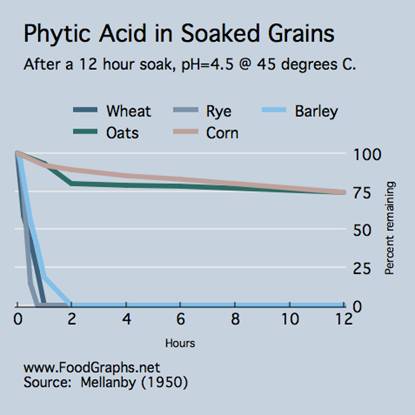PHYTASE enzymes break down phytate.
WHAT IS PHYTASE AND WHAT DOES IT DO?
♦ Phytase is any type of phosphatase enzyme that breaks down phytic acid (chemicallycalled dephosphorylation, produces a phosphate ion and a molecule with a free hydroxyl group) – phytase catalyzes the hydrolysis (requires water) of phytic acid by removing a phosphate group from its substrate to release a usable form of inorganic phosphorus. Phytase activity is measured in FTU (a worldwide standard).
♦ The break down of phytic acid by phytases results in two pointed beneficial effects – both of which increase mineral availability and absorption (esp. bone-beneficial phosphorus)
(1) Allows the utilization/absorption of bound/stored nutrients in phytate – phytase can hydrolyze phytic acid, releasing phosphorus and other nutrients bound by phytic acid (E.g. minerals, protein and starch );
(2) Prevents phytic acid from binding to important minerals in the digestive tract – which would otherwise make them unavailable to the body.
♦ Humans (and other non-ruminants) produce very few phytase enzymes for breaking down phytate – Humans and animals with one stomach (i.e. do not chew the cud) are unable to access the nutrients tied up in phytate. Note that even mice have 30 times more phytase than humans and therefore the results of rodent studies examining phytic acid breakdown and therefore do not likely apply to humans.
♦ In whole seed/grain, germination activates phytase – which breaks down phytate and releases phosphorus and other minerals needed by the developing plant embryo for new growth.
– Some grains contain more phytase than others – E.g. wheat contains 14 times more phytase than rice; rye contains over twice as much phytase as wheat.30 (the reason rye is preferred as a starter for sourdough breads).
√ Some grains contain insufficient phytase to eliminate their phytate – E.g. corn, oats, brown rice, millet), even when properly prepared.
√ In contrast – wheat, rye and barley contain high phytase levels
PHYTASE ACTIVITY DEPENDS ON PH
♦ Phytase activity depends on pH with Ideal pH being somewhere in the ~4.5 – 5.5 range –adding a mild acid to soaking water of phytate foods creates that “just right” pH environment for phytase action. Note that the stomach acid pH is much lower and not conducive to phytase activity.
– “pH was the most important factor in reducing the content of phytic acid during bread making as phytic acid in doughs with pH 4.3–4.6 was more effectively reduced than in doughs with higher pH.”
Phytase activity and degradation of phytic acid during rye bread making by Merete Møller Nielsen · Marianne Linde Damstrup · Agnete Dal Thomsen · Søren Kjærsg˚ rd Rasmussen · Åse Hansen Eur Food Res Technol 2007
– Reale et al concluded that lactic acid bacteria improved conditions for degrading phytate simply by lowering pH – they determined the ideal pH to be ~ 5.5
Reale A, Konietzny U, Coppola R, Sorrentino E, and Greiner R, 2007, ‘The importance of lactic acid bacteria for phytate degradation during cereal dough fermentation’, Journal of Agriculture and Food Chemistry, 55 (8), pp 2993-2997 ACSPub
– Phytase activities are pH dependent with the highest activities being observed at a slightly acidic pH ( 5.1).
Food Reviews International Phytic Acid by Lori Oatway a; Thava Vasanthan b; James H. Helm Field Crop Development Centre, Lacombe, Canada b Department of Agricultural Food and Nutritional Science, University of Alberta, Edmonton, Canada
– Bacterial flora in the colon produce phytase and also lactic acid that affects pH in favorof phytase activity – dephosphorylation of phytate releases Calcium ions, which are absorbed from the colon
Sandström, B., Cederblad, A., Stenquist, B., & Andersson, H. (1990). Effect of inositol
hexaphosphate on retention of zinc and calcium from the human colon.
European Journal of Clinical Nutrition, 44, 705–708.
PHYTASE ACTIVITY DEPENDS ON TEMPERATURE
♦ Phytase activity is increased within an ideal temperature range
♦ Phytase is reduced/destroyed by:
– Steam heat – 176 ⁰F in 10 mins. or less
– Heat-processing – such as being in a wet solution at 131-149 ⁰F
Peers FG. Phytase of Wheat. The Biochemical Journal 1953 53(1):102-110.
√ Extruded bran and whole grain cereals (E.g. All-bran ®, Bran Buds) are a recipe for digestive disaster and mineral deficiencies – Slurries of extremely high phytate grains are forced through tiny holes at high temperatures and pressures, which destroy the phytase enzymes that might have broken down some of the phytate – snap, crackle and pop goes your health!
√ Commercial oats have high phytic acid content but no phytase (destroyed by heat processing)
– Freezing and long storage times – fresh flour has more phytase than after being stored.
Campbell J and others. Nutritional Characteristics of Organic, Freshly stone-ground sourdough and conventional breads. http://eap.mcgill.ca/publications/EAP35.htm.
♦ Cooking alone is NOT enough to activate phytase for a significant reduction of phytic acid in grains and legumes – and cooking temperatures eventually destroy phytase altogether. To reduce phytic acid to a healthy level requires some preparation before cooking:
► Legumes should ideally be sprouted (i.e.germinated) or soaked in acidulated water as another option
► Grains should either acid soaked (i.e. partially fermented) then optionally sprouted (i.e.germinated) OR they should be soured (fully fermented as in sourdough)
http://healyourselfathome.com/HOW/NEWSTARTS/1_NUTRITION/ANTINUTRIENTS/PHYTATE/PHYTATE_phytase.aspx





